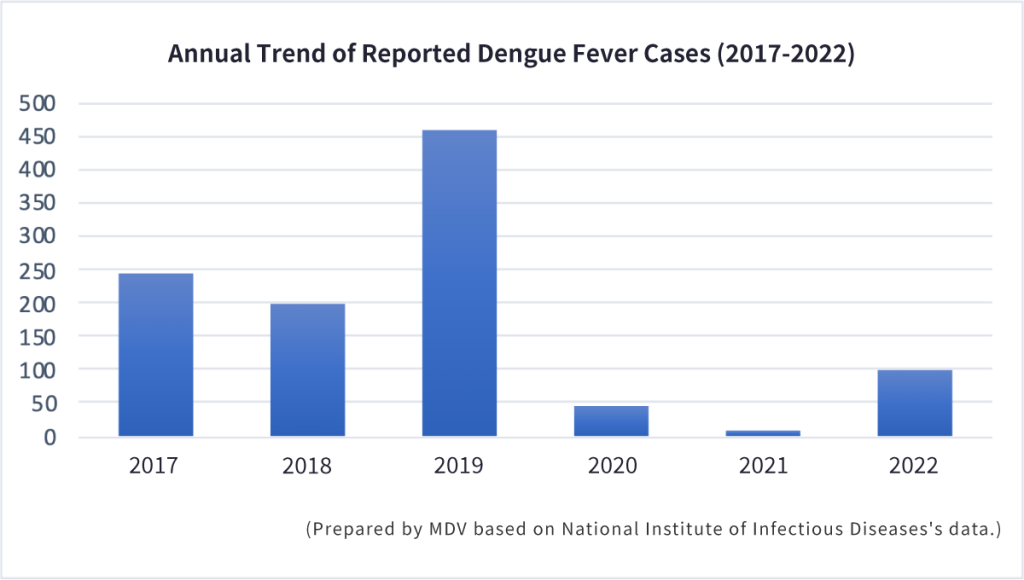
Comparison of the Annual Trends in the Number of Domestic Dengue Fever Patients since 2017
ADengue fever is an infectious disease transmitted by mosquitoes. It presents with a sudden high fever, rash, headache, bone and joint pain, and symptoms such as nausea and vomiting. Typically, the fever subsides within 2-7 days, and the rash appears during the defervescence period. However, a small proportion of patients may develop severe complications, such as dengue hemorrhagic fever or dengue shock syndrome, which can be fatal if not treated promptly and appropriately.
This year, dengue fever continues to rage worldwide. While Japan has not experienced an outbreak recently, there were confirmed domestic cases in 2014 for the first time in 70 years, with over 160 infections reported nationwide, primarily in Tokyo’s Yoyogi Park and other urban areas. The increase in inbound tourists is speculated to have played a role, and there is a concern that insecticide-resistant mosquitoes, such as Aedes albopictus, might invade Japan. Consequently, there is a possibility of a dengue fever outbreak in Japan this summer.
Therefore, we compared the reported cases from the National Institute of Infectious Diseases’ dengue fever surveillance with the actual patient numbers in MDV data.
Reference Materials:
Dengue Fever Definition from the Ministry of Health, Labour and Welfare’s website: Link
Graph/Report from the National Institute of Infectious Diseases (Infectious Disease Surveillance): “Table 2-1: Number of Reported Cases by Disease, Region, Prefecture, and Week (2017-2022)” Link

Based on the “Table 2-1: Number of Reported Cases by Disease, Region, Prefecture, and Week (2017-2022)” from the National Institute of Infectious Diseases, we created a unique dataset of nationwide infection numbers.

Data Period: January 2017 – December 2023
Criteria: Only hospitals with complete data for the specified period
Number of Facilities: 73
Both the National Institute of Infectious Diseases and MDV data show a peak in infections in 2019, with a subsequent decline from 2020 due to reduced international travel caused by the COVID-19 pandemic. With the easing of restrictions following the reclassification of COVID-19 as a Category V infectious disease in May 2022, international travel and inbound tourism have increased, which seems to have contributed to a rising trend in infections. The MDV data indicates that this increase in infections continues through 2023.
Annual Trend of Reported Dengue Fever Cases (2017-2022):
| Year | 2017 | 2018 | 2019 | 2020 | 2021 | 2022 |
| Cases | 245 | 201 | 461 | 45 | 8 | 98 |
Annual Trend of Actual Dengue Fever Patients in MDV Data (A90: Dengue Fever / A91: Dengue Hemorrhagic Fever):
| Year | 2017 | 2018 | 2019 | 2020 | 2021 | 2022 | 2023 |
| Cases | 34 | 40 | 69 | 14 | 6 | 16 | 28 |
Note: This article was published on July 1, 2024.
Data survey and analysis tailored to your specific requests
Databases, data analysis requests, and more.
© Medical Data Vision Co., Ltd. All Rights Reserved.





